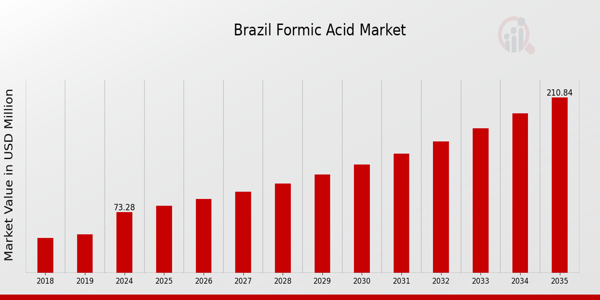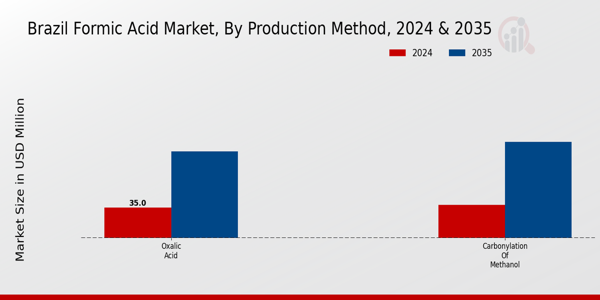Brazil Formic Acid Market Overview
The Brazil Formic Acid Market Size was estimated at 67.52 (USD Million) in 2024.The Brazil Formic Acid Industry is expected to grow from 73.28(USD Million) in 2025 to 210.84 (USD Million) by 2035. The Brazil Formic Acid Market CAGR (growth rate) is expected to be around 10.084% during the forecast period (2025 - 2035)
Key Brazil Formic Acid Market Trends Highlighted
The Brazil Formic Acid Market is experiencing several key trends driven by various factors. A significant market driver is the increasing demand for formic acid in agriculture as a preservative and acidifying agent in animal feed, which helps improve livestock quality and productivity. The Brazilian agricultural sector is robust, ranked among the largest producers of soybeans and sugarcane, generating a continuous need for agricultural inputs, including formic acid. Moreover, with Brazil's strong focus on sustainable agriculture practices, the non-toxic properties of formic acid make it an attractive choice for farmers looking to minimize the environmental impact of their operations.
Recent times have also seen an upward trend in the use of formic acid in leather tanning and textile production, industries that are prominent in Brazil. The country has a rich history in these sectors, and as global markets demand more sustainable and eco-friendly products, Brazilian manufacturers are increasingly adopting formic acid for its effectiveness. Additionally, there is growing interest in using this compound for renewable energy applications, particularly for fuel cells, which aligns with Brazil's efforts to promote clean energy sources. Opportunities to be explored in the Brazil Formic Acid Market include the development of local production facilities to reduce import dependency, thereby stabilizing supply chains and minimizing costs.
Furthermore, the government’s initiatives to stimulate industrial growth and enhance exports provide ample opportunities for formic acid producers to scale up their operations and expand their market reach within and outside Brazil. In summary, these trends reflect the evolving demands and opportunities within the Brazilian market for formic acid, paving the way for a dynamic landscape ahead.

Source: Primary Research, Secondary Research, MRFR Database and Analyst Review
Brazil Formic Acid Market Drivers
Growing Demand for Agrochemicals
The Brazil Formic Acid Market Industry is experiencing significant growth driven by the increasing demand for agrochemicals. Specifically, formic acid is utilized as a preservative in animal feed and as a crucial component in pesticide production. Brazil is one of the largest agricultural producers globally, with a USDA report indicating that Brazil's agricultural exports reached approximately 93 billion USD in recent years. This substantial agricultural output directly correlates with the increased need for formic acid, as it enhances feed efficiency and supports crop protection.
Additionally, the Brazilian Ministry of Agriculture has emphasized the importance of sustainable practices, further propelling the usage of environmentally friendly chemicals like formic acid and showcasing the double benefit of supporting both agricultural yield and eco-sustainability.
Expansion of Chemical Manufacturing in Brazil
The chemical manufacturing sector in Brazil is expanding, particularly in the production of organic compounds such as formic acid. Recent data from the Brazilian Institute of Geography and Statistics (IBGE) indicates that the chemical industry contributed over 10% to the country's industrial GDP. This growth is supported by investments from domestic and international companies setting up manufacturing plants in Brazil to cater to local and export markets.
As these companies scale their operations, the demand for essential chemicals like formic acid is anticipated to rise, thus propelling the Brazil Formic Acid Market Industry forward.
Increase in Livestock Production
The Brazil Formic Acid Market Industry is influenced by the rising livestock production in the country. Reports from the Brazilian Association of Animal Proteins (ABPA) indicate a consistent year-on-year growth in livestock numbers, with poultry alone growing by 4% to reach over 14 million tons in 2021. Formic acid serves as an effective feed additive, improving digestion and productivity in livestock. This increasing focus on improving livestock health and productivity among Brazil's farmers is expected to contribute significantly to the growth of the formic acid market as regional producers adopt innovative solutions like formic acid to meet the rising demands for protein-based foods.
Supportive Regulatory Frameworks
The regulatory environment in Brazil is increasingly supportive of the use of organic acids like formic acid, which are deemed safer for the environment. The Brazilian government has enacted policies that encourage the use of biopesticides and natural feed additives, aligning with global trends toward sustainable agriculture. The National Health Surveillance Agency (ANVISA) has approved several applications of formic acid in agriculture, easing the pathway for these products in the market.
This supportive regulatory framework is set to create more opportunities for the Brazil Formic Acid Market Industry as companies innovate and invest more in products that comply with these regulations.
Brazil Formic Acid Market Segment Insights
Formic Acid Market Production Method Insights
The Brazil Formic Acid Market encapsulates various production methods that are pivotal in shaping its landscape. Among these, the production method via oxalic acid is noteworthy due to its efficiency in yielding high-purity formic acid, which is crucial for various applications ranging from textiles to the leather industry. Oxalic acid serves as a foundation for the production process, guaranteeing quality and market suitability. Additionally, the carbonylation of methanol is another critical method that stands out, driven by industrial demand and the versatility of methanol as a feedstock.
This method benefits from lower production costs and a reduced environmental footprint, making it attractive in current sustainability-focused markets. The reliance on these production methods underlines an increasing trend in Brazil towards adopting processes that not only optimize yield but also minimize ecological impact. Market analysis suggests that the collaborative efforts between production techniques will enhance the overall revenue potential of the Brazil Formic Acid Market, establishing competitive pricing and product diversity. As these methods evolve, Brazil's emphasis on innovation and cleaner technologies aligns with global market dynamics, offering numerous opportunities for growth amidst the challenges posed by regulatory frameworks and raw material sourcing.
The Brazilian government’s commitment to fostering chemical industry growth, particularly in sustainable practices, is likely to bolster the usage of such production methods moving forward.

Source: Primary Research, Secondary Research, MRFR Database and Analyst Review
Formic Acid Market Application Insights
The Application segment of the Brazil Formic Acid Market portrays diverse opportunities across various industries, with significant contributions from sectors such as rubber and leather production, cleaning agents, and textile finishing. Brazil's robust agriculture and leather industries drive demand for formic acid as a preservative and in dyeing processes, linking the chemical's utility to economic activity. The cleaning agent application showcases increasing household and industrial preferences for eco-friendly solutions, thereby enhancing market growth.
Furthermore, the animal feed sector benefits from formic acid's antibacterial properties, which contribute to livestock health. As Brazil emphasizes sustainability in its production methods, formic acid's application in preservatives and textile processing aligns with both health regulations and environmental considerations. The growing trend towards biodegradable products further influences the Brazil Formic Acid Market dynamics, indicating a shift in consumer preferences and promoting innovations in chemical applications. This segment's versatility demonstrates its integral role in various production processes, reinforcing the overall market landscape and positioning Brazil as a key player in the formic acid global supply chain.
Brazil Formic Acid Market Key Players and Competitive Insights
The Brazil Formic Acid Market demonstrates a dynamic competitive landscape characterized by various players vying for market share within the chemical sector. As a key component in several industrial applications, formic acid's significance is growing in Brazil, fueled by its use in textiles, leather, agriculture, and food preservation. The market is influenced by local demand and supply dynamics, regulatory frameworks, and global pricing trends. Understanding the competitive environment is vital for companies aiming to establish a foothold or expand their presence in this sector as they navigate challenges like sustainability initiatives and innovative product development. The market's potential is further amplified by the increasing awareness of the benefits of formic acid, prompting both domestic and international companies to invest in enhancing their product offerings and operational efficiency to capture the evolving demand.
Shandong Shouguang Juneng Chemical has emerged as an influential player in the Brazil Formic Acid Market, primarily due to its robust production capabilities and extensive product line. The company's strengths lie in its ability to manufacture high-quality formic acid that meets international standards, catering to various industries such as agriculture and textiles. With a significant manufacturing facility that ensures a steady supply of formic acid, Shandong Shouguang Juneng Chemical is well-positioned to capitalize on the growing demand within Brazil. Moreover, the company's strategic partnerships and collaborations have enhanced its distribution network, allowing for effective penetration into major Brazilian cities. Their commitment to customer satisfaction through consistent product quality and innovation has solidified their reputation among local distributors and end-users in the market.
Zhejiang Jianfeng Chemical holds a vital position in the Brazil Formic Acid Market, recognized for its comprehensive portfolio of chemical products and a strong commitment to sustainability. Key offerings include formic acid used in various applications, such as animal feed additives and leather tanning agents, supporting their penetration into diverse industrial sectors in Brazil. The company's competitive advantage stems from its rigorous quality control measures and research and development initiatives aimed at creating value-added products. Zhejiang Jianfeng Chemical has also engaged in strategic mergers and acquisitions, allowing it to enhance its market presence and operational capabilities within Brazil. These strategic moves not only expand their manufacturing capacity but also improve their distribution efficiency across the region. With a focus on sustainable practices, the company's initiatives resonate well with local regulations and consumer preferences, positioning it favorably in an increasingly eco-conscious market landscape.
Key Companies in the Brazil Formic Acid Market Include
- Shandong Shouguang Juneng Chemical
- Zhejiang Jianfeng Chemical
- Chaozhou ThreeCircle Group
- Merck KGaA
- Honywell
- Perstorp
- Shandong Kairun Chemical
- Wuhan Huitong Chemical
- Jiangshan Chemical
- Eastman Chemical
- Hunan Chemical
- Shijiazhuang Sanyuan Chemical
- Sichuan Tianhua Fengguang Chemical
- BASF
Brazil Formic Acid Market Industry Developments
The Brazil Formic Acid Market is currently witnessing significant developments. Recent reports indicate an increased production capacity among local players, with companies such as Hunan Chemical and Jiangshan Chemical ramping up manufacturing to meet the growing demand from various sectors, including agriculture and textiles. In terms of mergers and acquisitions, Shandong Shouguang Juneng Chemical announced plans in August 2023 to acquire a minority stake in a Brazilian chemical firm to enhance its market reach in South America, supported by strategic partnerships aiming to boost technology transfer and product development.
Additionally, BASF and Merck KGaA have been focusing on expanding their operational footprint in Brazil, enhancing their competitive position through capital investments. The overall growth in the market valuation of these companies has had a considerable impact, spurring innovation and improving supply chain logistics. Notably, Brazil's agricultural sector, which is the world's third-largest producer of grains, continues to drive the demand for formic acid as a preservative and antimicrobial agent, illustrating the critical role this chemical plays in various industrial applications. The robust economic growth and supportive government policies are set to further elevate the prospects of the Brazil Formic Acid Market.
Formic Acid Market Segmentation Insights
Formic Acid Market Production Method Outlook
- oxalic acid
- carbonylation of methanol
Formic Acid Market Application Outlook
- rubber
- leather production
- cleaning agent
- finishing textile
- preservatives
- dyeing
- animal feed
- others
| Report Attribute/Metric Source: |
Details |
| MARKET SIZE 2023 |
67.52(USD Million) |
| MARKET SIZE 2024 |
73.28(USD Million) |
| MARKET SIZE 2035 |
210.84(USD Million) |
| COMPOUND ANNUAL GROWTH RATE (CAGR) |
10.084% (2025 - 2035) |
| REPORT COVERAGE |
Revenue Forecast, Competitive Landscape, Growth Factors, and Trends |
| BASE YEAR |
2024 |
| MARKET FORECAST PERIOD |
2025 - 2035 |
| HISTORICAL DATA |
2019 - 2024 |
| MARKET FORECAST UNITS |
USD Million |
| KEY COMPANIES PROFILED |
Shandong Shouguang Juneng Chemical, Zhejiang Jianfeng Chemical, Chaozhou ThreeCircle Group, Merck KGaA, Honywell, Perstorp, Shandong Kairun Chemical, Wuhan Huitong Chemical, Jiangshan Chemical, Eastman Chemical, Hunan Chemical, Shijiazhuang Sanyuan Chemical, Sichuan Tianhua Fengguang Chemical, BASF |
| SEGMENTS COVERED |
Production Method, Application |
| KEY MARKET OPPORTUNITIES |
Growing agricultural sector demand, Increasing industrial applications, Sustainable production methods adoption, Expanding pharmaceutical uses, Rising need for leather processing |
| KEY MARKET DYNAMICS |
Growing demand in agriculture, Environmental regulations shaping supply, Increasing industrial applications, Fluctuating raw material prices, Expansion of production capacities |
| COUNTRIES COVERED |
Brazil |
Frequently Asked Questions (FAQ) :
The Brazil Formic Acid Market is expected to be valued at 73.28 million USD in 2024.
By 2035, the Brazil Formic Acid Market is anticipated to reach a valuation of 210.84 million USD.
The market is projected to grow at a CAGR of 10.084% from 2025 to 2035.
The primary production methods for formic acid in Brazil are the oxalic acid method and carbonylation of methanol.
The oxalic acid production method is valued at 35.0 million USD in the Brazil Formic Acid Market for the year 2024.
The carbonylation of methanol is projected to be valued at 110.84 million USD in 2035.
Major players in the Brazil Formic Acid Market include companies like Shandong Shouguang Juneng Chemical, Merck KGaA, and BASF among others.
The Brazil Formic Acid Market presents growth opportunities driven by increasing applications in agriculture, leather processing, and textiles.
Challenges such as fluctuating raw material prices and environmental regulations may impact the Brazil Formic Acid Market in the future.
Key applications driving growth include the production of pesticides, preservatives, and rubber processing within the Brazil Formic Acid Market.
















